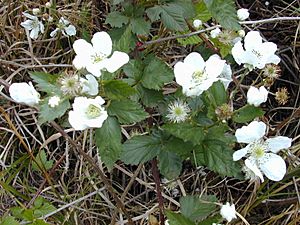Rubus argutus facts for kids
Quick facts for kids Rubus argutus |
|
|---|---|
 |
|
 |
|
| Conservation status | |
| Scientific classification | |
| Genus: |
Rubus
|
| Species: |
argutus
|
| Synonyms | |
|
Synonymy
Rubus abundiflorus L.H.Bailey
Rubus betulifolius Small Rubus floridensis L.H.Bailey Rubus floridus Tratt. Rubus incisifrons L.H.Bailey Rubus louisianus A.Berger Rubus penetrans L.H.Bailey Rubus rhodophyllus Rydb. |
|
Rubus argutus is a type of bramble plant found in North America. It belongs to the rose family. This plant is known for its prickles (sharp points).
You might know Rubus argutus by its common names: sawtooth blackberry or tall blackberry. It gets these names because it can grow quite tall, up to 2 meters (about 6.5 feet) high! This plant lives for many years. It grows naturally in the eastern and south-central parts of the United States. You can find it from Florida all the way to Texas, Missouri, Illinois, and Maine.
Contents
What Does It Look Like?
It's easy to spot a Rubus argutus plant if you know what to look for.
Plant Structure
- These plants are usually woody shrubs or climbing vines.
- They have sharp thorns on their stems, leaves, and even near their flowers.
Leaves
- The leaves grow in an alternating pattern along the stem.
- They are "palmately compound," which means they look a bit like the palm of your hand with several leaflets spreading out.
- Young plants (first year) have leaves with five leaflets.
- Older plants (second year) have leaves with three leaflets.
Flowers
- Second-year plants grow clusters of flowers. These clusters are called "racemes."
- Each cluster can have between five and twenty flowers.
- The flowers usually have five large, white petals.
- They also have light green sepals, which are like small leaves that protect the flower bud.
- These flowers typically bloom in the middle of spring.
Life Cycle of the Blackberry
The life cycle of the sawtooth blackberry is interesting.
Fruit Development
- Only second-year plants can grow fruit.
- The fruit is what we call a blackberry.
- Blackberries are made up of many small, juicy parts called "drupelets."
- When the fruit is young, it is bright red.
- As it ripens, it turns black.
- Each tiny drupelet inside the blackberry holds a single seed.
Plant's End and New Growth
- After a second-year plant produces fruit, it dies.
- But don't worry! New plants will grow from the underground parts of the old plant. This way, the blackberry patch keeps growing year after year.
Uses of Blackberries
Blackberries are not just tasty; they have been used for other things too!
Edible Berries
- There are many different kinds of blackberries, and they are all safe to eat.
- They might differ in size, but they are all delicious!
Traditional Uses
- For a long time, blackberry leaves were listed in the official U.S. pharmacopoeia. This means they were recognized for their medicinal uses.
- People believed that blackberry leaves could help with tummy troubles, especially diarrhea.
- You can also dry the leaves to make a nice tea. It's good to drink even if you're feeling perfectly healthy!

All content from Kiddle encyclopedia articles (including the article images and facts) can be freely used under Attribution-ShareAlike license, unless stated otherwise. Cite this article:
Rubus argutus Facts for Kids. Kiddle Encyclopedia.

